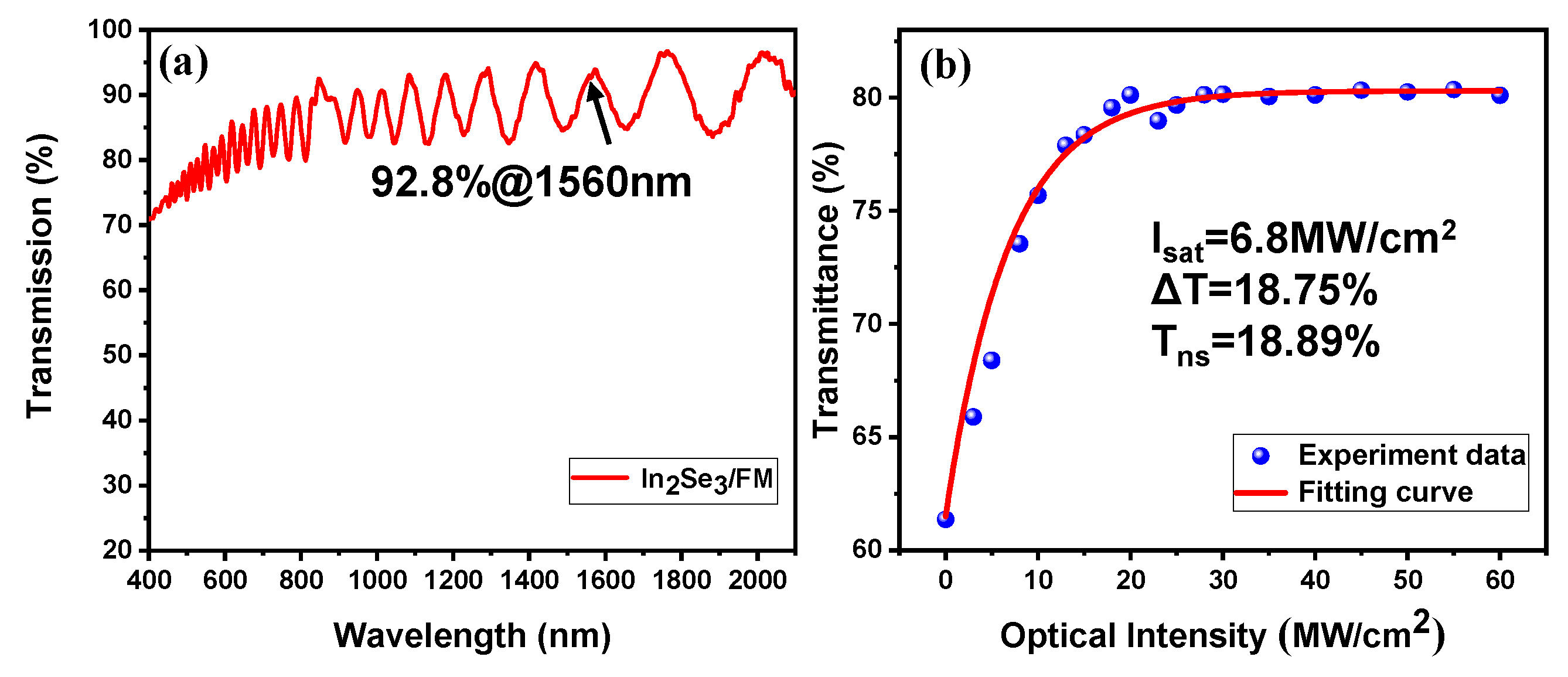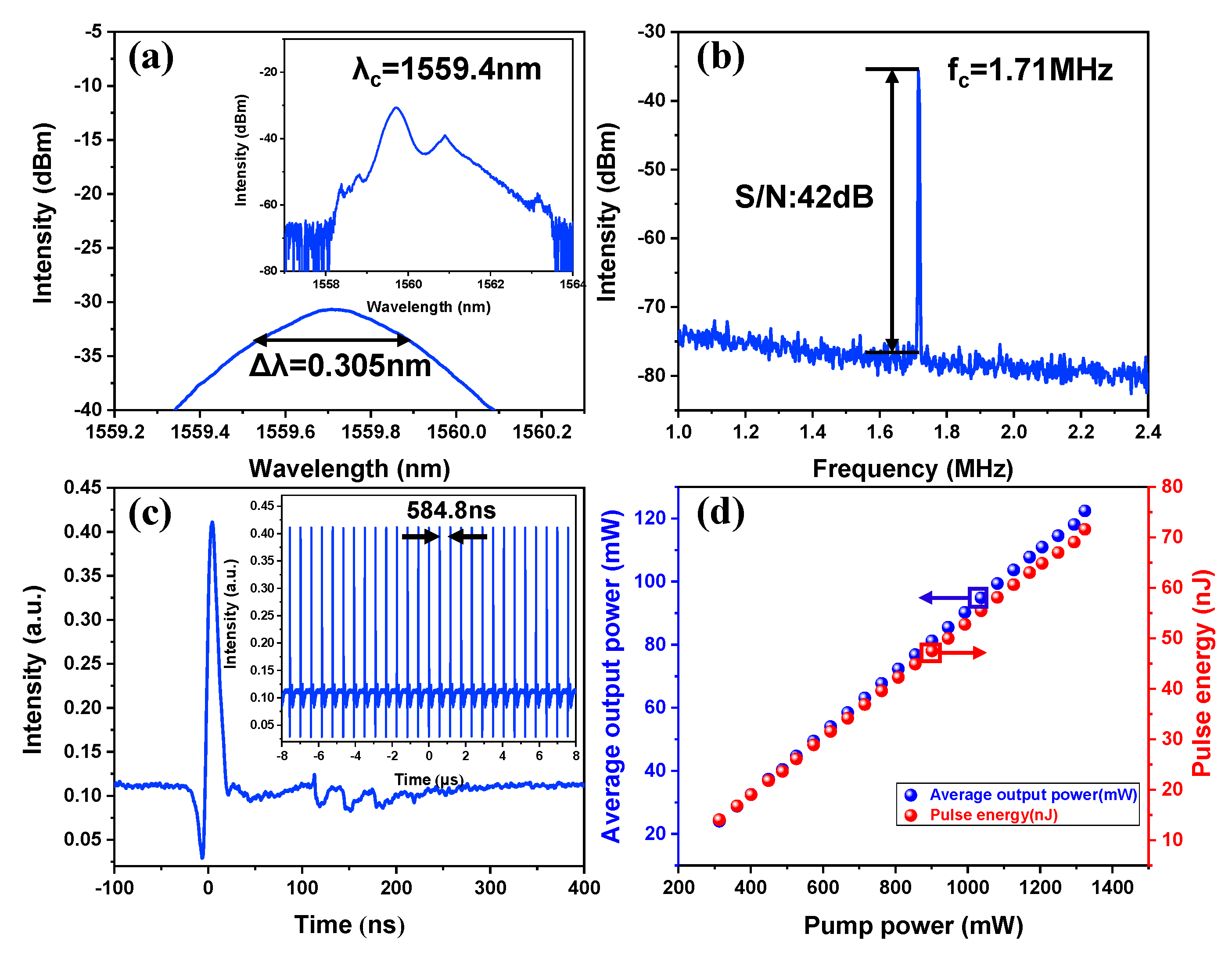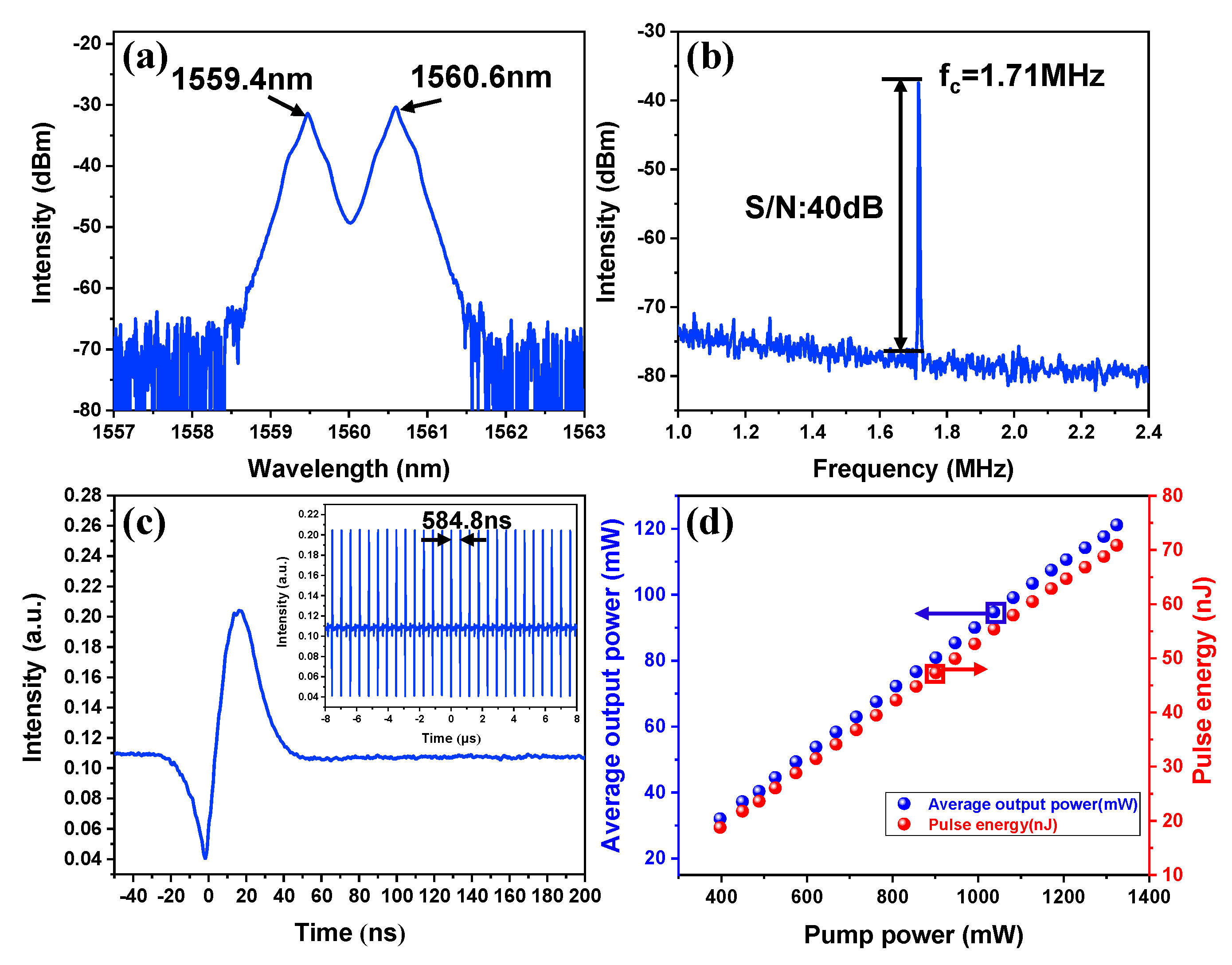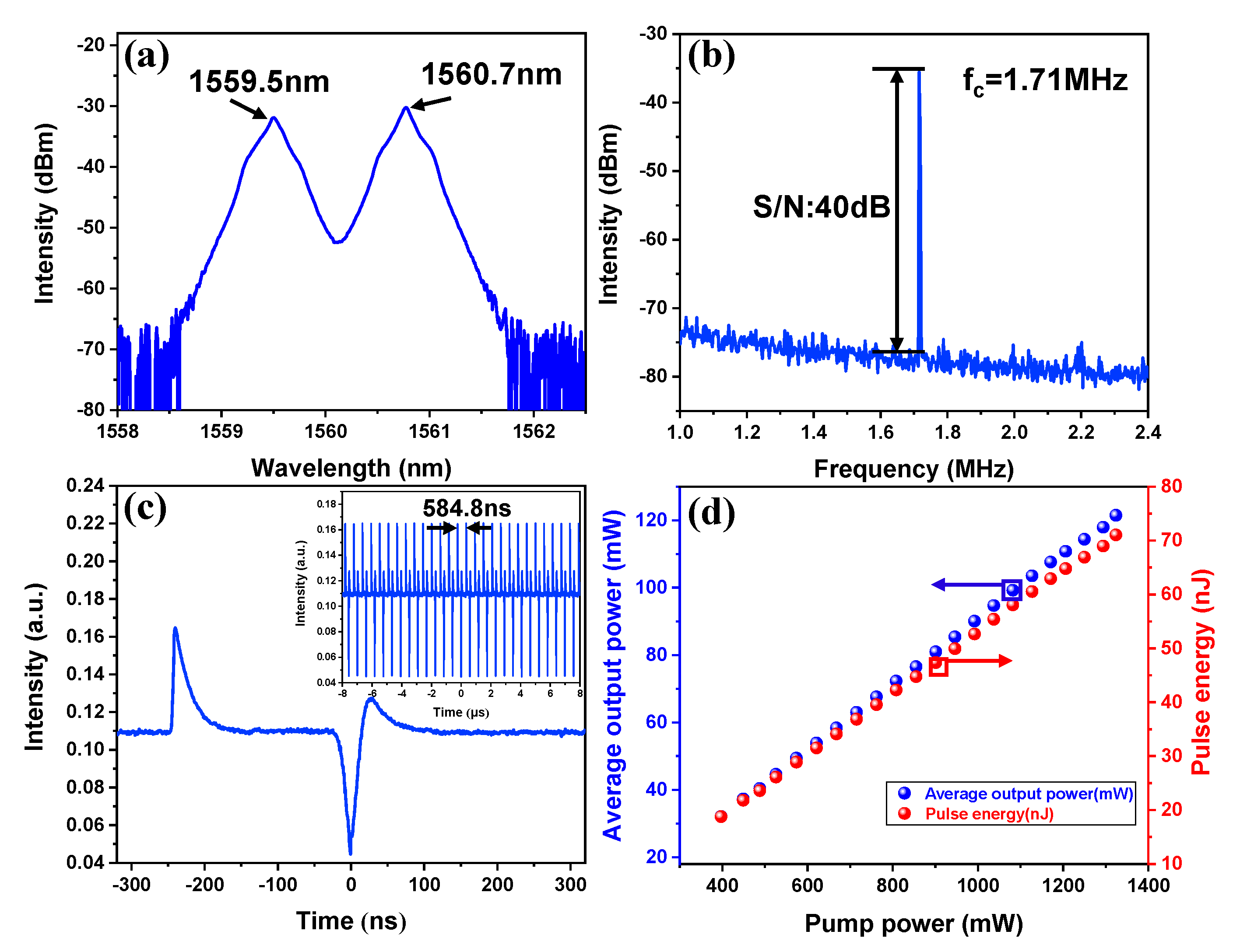Improved Laser Damage Threshold of In2Se3 Saturable Absorber by PVD for High-Power Mode-Locked Er-Doped Fiber Laser
Abstract
:1. Introduction
2. Preparation and Characterization of the In2Se3 SA
2.1. Synthesis and Characterization of In2Se3 Flakes
2.2. Preparation and Characterization of In2Se3 SA
3. Experimental Setup
4. Experimental Results and Discussions
4.1. Bright Pulses
4.2. Dark-Bright Pulse Pairs
5. Conclusions
Author Contributions
Funding
Conflicts of Interest
References
- Ivanenko, A.; Kobtsev, S.; Smirnov, S.; Kemmer, A. Mode-locked long fibre master oscillator with intra-cavity power management and pulse energy >12 μJ. Opt. Express 2016, 24, 6650–6655. [Google Scholar] [CrossRef] [PubMed]
- Liu, J.; Xu, J.; Wang, P. High Repetition-Rate Narrow Bandwidth SESAM Mode-Locked Yb-Doped Fiber Lasers. IEEE Photonics Technol. Lett. 2018, 24, 539–541. [Google Scholar] [CrossRef]
- Luo, Z.C.; Luo, A.P.; Xu, W.C. Tunable and Switchable Multiwavelength Passively Mode-Locked Fiber Laser Based on SESAM and Inline Birefringence Comb Filter. IEEE Photonics J. 2011, 3, 64–70. [Google Scholar]
- Yamashita, S.; Inoue, Y.; Maruyama, S.; Murakami, Y.; Yaguchi, H.; Jablonski, M.; Set, S.Y. Saturable absorbers incorporating carbon nanotubes directly synthesized onto substrates and fibers and their application to mode-locked fiber lasers. Opt. Lett. 2004, 29, 1581–1583. [Google Scholar] [CrossRef] [PubMed]
- Sun, Z.; Hasan, T.; Wang, F.; Rozhin, A.G.; White, I.H.; Ferrari, A.C. Ultrafast stretched-pulse fiber laser mode-locked by carbon nanotubes. Nano Res. 2010, 3, 404–411. [Google Scholar] [CrossRef] [Green Version]
- Chernysheva, M.; Rozhin, A.; Fedotov, Y.; Mou, C.; Arif, R.; Kobtsev, S.M.; Dianov, E.M.; Turitsyn, S.K. Carbon nanotubes for ultrafast fibre lasers. Nanophotonics 2017, 6, 1–30. [Google Scholar] [CrossRef]
- Sun, Z.; Hasan, T.; Torrisi, F.; Popa, D.; Privitera, G.; Wang, F.; Bonaccorso, F.; Basko, D.M.; Ferrari, A.C. Graphene Mode-Locked Ultrafast Laser. ACS Nano 2010, 4, 803–810. [Google Scholar] [CrossRef] [PubMed] [Green Version]
- Xu, S.C.; Man, B.Y.; Jiang, S.Z.; Hu, G.D.; Dong, H.L.; Liu, J.; Chen, C.S.; Liu, M.; Yang, C.; Feng, D.J.; et al. High-power ultrafast Nd:YVO4 laser mode-locked by graphene saturable absorber. Opt. Laser Technol. 2014, 64, 288–291. [Google Scholar] [CrossRef]
- Zhang, H.; Bao, Q.L.; Tang, D.Y.; Zhao, L.M.; Loh, K. Large energy soliton erbium-doped fiber laser with a graphene-polymer composite mode locker. Appl. Phys. Lett. 2009, 95, 141103. [Google Scholar] [CrossRef]
- Guo, B.; Lyu, Q.; Yao, Y.; Wang, P.F. Direct generation of dip-type sidebands from WS2 mode-locked fiber laser. Opt. Mater. Express 2016, 6, 2475–2486. [Google Scholar] [CrossRef]
- Niu, K.D.; Chen, Q.Y.; Sun, R.Y.; Man, B.Y.; Zhang, H.N. Passively Q-switched erbium-doped fiber laser based on SnS2 saturable absorber. Opt. Mater. Express 2017, 7, 3934–3943. [Google Scholar] [CrossRef]
- Niu, K.D.; Sun, R.Y.; Chen, Q.Y.; Man, B.Y.; Zhang, H.N. Passively mode-locked Er-doped fiber laser based on SnS2 nanosheets as a saturable absorber. Photonics Res. 2018, 6, 72–76. [Google Scholar] [CrossRef]
- Xia, H.D.; Li, H.P.; Lan, C.Y.; Li, C.; Zhang, X.X.; Zhang, S.J.; Liu, Y. Ultrafast erbium-doped fiber laser mode-locked by a CVD-grown molybdenum disulfide (MoS2) saturable absorber. Opt. Express 2014, 22, 17341–17348. [Google Scholar] [CrossRef] [PubMed]
- Woodward, R.I.; Kelleher, E.J.R. 2D Saturable Absorbers for Fibre Lasers. Appl. Sci. 2015, 5, 1440–1456. [Google Scholar] [CrossRef] [Green Version]
- Li, Z.; Zhang, C.; Han, Y.S.; Gao, S.S.; Sheng, Y.Q.; Zhang, S.Z.; Lu, Z.Y.; Man, B.Y.; Jiao, Y.; Jiang, S.Z. Evanescent wave absorption sensor with direct-growth MoS2 film based on U-bent tapered multimode fiber. J. Phys. D Appl. Phys. 2017, 50, 315302. [Google Scholar] [CrossRef]
- Xu, N.N.; Zhang, H.N.; Yang, W.Q.; Han, X.L.; Man, B.Y. High-efficiency passively Q-switched neodymium-doped fiber laser operation at 1360.61nm with bismuth selenide as saturable absorber. Laser Phys. 2018, 28, 125801. [Google Scholar] [CrossRef]
- Xu, N.N.; Zhang, H.N.; Man, B.Y. Various large-energy soliton operations within an Er-doped fiber laser with bismuth selenide as a saturable absorber. Appl. Opt. 2018, 57, 8811–8818. [Google Scholar] [CrossRef]
- Guo, B.; Yao, Y.; Tian, J.J.; Zhao, Y.F.; Liu, S.; Li, M.; Quan, M.R. Observation of Bright-Dark Soliton Pair in a Mode-Locked Fiber Laser with Topological Insulator. IEEE Photonics Technol. Lett. 2015, 27, 701–704. [Google Scholar] [CrossRef]
- Sotor, J.; Sobon, G.; Grodecki, K.; Abramski, K.M. Mode-locked erbium-doped fiber laser based on evanescent field interaction with Sb2Te3 topological insulator. Appl. Phys. Lett. 2014, 104, 251112. [Google Scholar] [CrossRef]
- Bernard, F.; Zhang, H.; Gorza, S.P.; Emplit, P. Towards mode-locked fiber laser using topological insulators. In Nonlinear Photonics; OSA Technical Digest (online) (Optical Society of America): Washington, DC, USA, 2012. [Google Scholar]
- Sotor, J.; Sobon, G.; Kowalczyk, M.; Macherzynski, W.; Paletko, P.; Abramski, K.M. Ultrafast thulium-doped fiber laser mode locked with black phosphorus. Opt. Lett. 2015, 40, 3885–3888. [Google Scholar] [CrossRef]
- Luo, Z.C.; Liu, M.; Guo, Z.N.; Jiang, X.F.; Luo, A.P.; Zhao, C.J.; Yu, X.F.; Xu, W.C.; Zhang, H. Microfiber-based few-layer black phosphorus saturable absorber for ultra-fast fiber laser. Opt. Express 2015, 23, 20030–20039. [Google Scholar] [CrossRef] [PubMed]
- Kwon, S.H.; Ahn, B.T.; Kim, S.K.; Yoon, K.H.; Song, J. Growth of CuIn3Se5 layer on CuInSe2 films and its effect on the photovoltaic properties of In2Se3/CuInSe2 solar cells. Thin Solid Films 1998, 323, 265–269. [Google Scholar] [CrossRef]
- Mafi, E.; Soudi, A.; Gu, Y. Electronically Driven Amorphization in Phase-Change In2Se3 Nanowires. J. Phys. Chem. C 2012, 116, 22539–22544. [Google Scholar] [CrossRef]
- Li, Q.L.; Li, Y.; Gao, J.; Wang, S.D.; Sun, X.H. High performance single In2Se3 nanowire photodetector. Appl. Phys. Lett. 2011, 99, 243105. [Google Scholar] [CrossRef]
- Ye, J.P.; Soeda, S.; Nakamura, Y.; Nittono, O. Crystal structures and phase transformation in In2Se3 compound semiconductor. Jpn. J. Appl. Phys. 1998, 37, 4264–4271. [Google Scholar] [CrossRef]
- Feng, W.; Zheng, W.; Gao, F.; Chen, X.S.; Liu, G.B.; Hasan, T.; Cao, W.W.; Hu, P.A. Sensitive Electronic-Skin Strain Sensor Array Based on the Patterned Two-Dimensional α-In2Se3. Chem. Mater. 2016, 28, 4278–4283. [Google Scholar] [CrossRef]
- Feng, W.; Gao, F.; Hu, Y.X.; Dai, M.J.; Li, H.; Wang, L.F.; Hu, P.A. High performance and flexible photodetectors based on chemical vapor deposition grown two-dimensional In2Se3 nanosheets. Nanotechnology 2018, 29, 445205. [Google Scholar] [CrossRef]
- Jacobs-Gedrim, R.B.; Shanmugam, M.; Jain, N.; Durcan, C.A.; Murphy, M.T.; Murray, T.M.; Matyi, R.J.; Moore, R.L.; Yu, B. Extraordinary Photoresponse in Two-Dimensional In2Se3 Nanosheets. ACS Nano 2013, 8, 514–521. [Google Scholar] [CrossRef]
- Zhou, Y.; Wu, D.; Zhu, Y.H.; Cho, Y.J.; He, Q.; Yang, X.; Herrera, K.; Chu, Z.D.; Han, Y.; Downer, M.C.; et al. Out-of-Plane Piezoelectricity and Ferroelectricity in Layered α-In2Se3 Nanoflakes. Nano Lett. 2017, 17, 5508–5513. [Google Scholar] [CrossRef]
- Zhou, J.D.; Zeng, Q.S.; Lv, D.H.; Sun, L.F.; Niu, L.; Fu, W.; Liu, F.C.; Shen, Z.X.; Jin, C.H.; Liu, Z. Controlled Synthesis of High-Quality Monolayered α-In2Se3 via Physical Vapor Deposition. Nano Lett. 2015, 15, 6400–6405. [Google Scholar] [CrossRef]
- Yan, P.G.; Jiang, Z.K.; Chen, H.; Yin, J.D.; Lai, J.T.; Wang, J.Z.; He, T.C.; Yang, J.B. α-In2Se3 wideband optical modulator for pulsed fiber lasers. Opt. Lett. 2018, 43, 4417–4420. [Google Scholar] [CrossRef] [PubMed]
- Cui, C.J.; Hu, W.J.; Yan, X.X.; Addiego, C.; Gao, W.P.; Wang, Y.; Wang, Z.; Li, L.Z.; Cheng, Y.C.; Li, P.; et al. Intercorrelated In-Plane and Out-of-Plane Ferroelectricity in Ultrathin Two-Dimensional Layered Semiconductor In2Se3. Nano Lett. 2018, 18, 1253–1258. [Google Scholar] [CrossRef] [PubMed]
- Ming, N.; Tao, S.N.; Yang, W.Q.; Chen, Q.Y.; Sun, R.Y.; Wang, C.; Wang, S.Y.; Man, B.Y.; Zhang, H.N. Mode-locked Er-doped fiber laser based on PbS/CdS core/shell quantum dots as saturable absorber. Opt. Express 2018, 26, 9017–9026. [Google Scholar] [CrossRef] [PubMed]
- Sotor, J.; Sobon, G.; Krzempek, K.; Abramski, K.M. Fundamental and harmonic mode-locking in erbium-doped fiber laser based on graphene saturable absorber. Opt. Commun. 2012, 285, 3174–3178. [Google Scholar] [CrossRef]
- Choi, S.Y.; Cho, D.K.; Song, Y.W.; Oh, K.; Kim, K.; Rotermund, F.; Yeom, D.I. Graphene-filled hollow optical fiber saturable absorber for efficient soliton fiber laser modelocking. Opt. Express 2012, 20, 5652–5657. [Google Scholar] [CrossRef] [PubMed]
- Guo, B.; Yao, Y.; Yang, Y.F.; Yuan, Y.J.; Jin, L.; Yan, B.; Zhang, J.Y. Dual-wavelength rectangular pulse erbium-doped fiber laser based on topological insulator saturable absorber. Photon. Res. 2015, 3, 94–99. [Google Scholar] [CrossRef]
- Yan, P.G.; Lin, R.Y.; Ruan, S.C.; Liu, A.J.; Chen, H. A 2.95 GHz, femtosecond passive harmonic mode-locked fiber laser based on evanescent field interaction with topological insulator film. Opt. Express 2015, 23, 154–164. [Google Scholar] [CrossRef]
- Wang, Q.K.; Chen, Y.; Miao, L.L.; Jiang, G.B.; Chen, S.Q.; Liu, J.; Fu, X.Q.; Zhao, C.J.; Zhang, H. Wide spectral and wavelength-tunable dissipative soliton fiber laser with topological insulator nano-sheets self-assembly films sandwiched by PMMA polymer. Opt. Express 2015, 23, 7681–7693. [Google Scholar] [CrossRef]
- Lee, J.; Koo, J.; Lee, J.H. A pulse-width-tunable, mode-locked fiber laser based on dissipative soliton resonance using a bulk-structured Bi2Te3 topological insulator. Opt. Eng. 2016, 55, 081309. [Google Scholar] [CrossRef]
- Liu, W.J.; Pang, L.H.; Han, H.N.; Tian, W.L.; Chen, H.; Lei, M.; Yan, P.G.; Wei, Z.Y. Generation of dark solitons in erbium-doped fiber lasers based Sb2Te3 saturable absorbers. Opt. Express 2015, 23, 26023–26031. [Google Scholar] [CrossRef]
- Yan, P.G.; Chen, H.; Yin, J.D.; Xu, Z.H.; Li, J.R.; Jiang, Z.K.; Zhang, W.F.; Wang, J.Z.; Li, I.L.; Sun, Z.P.; et al. Large-Area Tungsten Disulfide for Ultrafast Photonics. Nanoscale 2017, 9, 1871–1877. [Google Scholar] [CrossRef] [PubMed]
- Guo, B.; Li, S.; Fan, Y.X.; Wang, P.F. Versatile soliton emission from a WS2 mode-locked fiber laser. Opt. Commun. 2018, 406, 66–71. [Google Scholar] [CrossRef]
- Liu, W.J.; Pang, L.H.; Han, H.N.; Bi, K.; Lei, M.; Wei, Z.Y. Tungsten disulphide for ultrashort pulse generation in all-fiber lasers. Nanoscale 2017, 9, 5806–5811. [Google Scholar] [CrossRef] [PubMed]
- Liu, W.J.; Liu, M.L.; OuYang, Y.Y.; Hou, H.R.; Ma, G.L.; Lei, M.; Wei, Z.Y. Tungsten diselenide for mode-locked erbium-doped fiber lasers with short pulse duration. Nanotechnology 2018, 29, 174002. [Google Scholar] [CrossRef] [PubMed]
- Liu, W.J.; Liu, M.L.; Yin, J.D.; Chen, H.; Lu, W.; Fang, S.B.; Teng, H.; Lei, M.; Yan, P.G.; Wei, Z.Y. Tungsten diselenide for all-fiber lasers with chemical vapor deposition method. Nanoscale 2018, 10, 7971–7977. [Google Scholar] [CrossRef] [PubMed]
- Koo, J.; Park, J.; Lee, J.; Jhon, Y.M.; Lee, J.H. Femtosecond harmonic mode-locking of a fiber laser at 3.27 GHz using a bulk-like, MoSe2-based saturable absorber. Opt. Express 2015, 24, 10575–10589. [Google Scholar] [CrossRef] [PubMed]
- Wang, J.T.; Jiang, Z.K.; Chen, H.; Li, J.R.; Yin, J.D.; Wang, J.Z.; He, T.C.; Yan, P.G.; Ruan, S.C. High energy soliton pulse generation by a magnetron-sputtering-deposition-grown MoTe2 saturable absorber. Photonics Res. 2018, 6, 535–541. [Google Scholar] [CrossRef]
- Lu, F.F. Passively harmonic mode-locked fiber laser based on ReS2 saturable absorber. Mod. Phys. Lett. B 2017, 31, 1750206. [Google Scholar] [CrossRef]
- Ning, Q.Y.; Wang, S.K.; Luo, A.P.; Lin, Z.B.; Luo, Z.C.; Xu, W.C. Bright-Dark Pulse Pair in a Figure-Eight Dispersion-Managed Passively Mode-Locked Fiber Laser. IEEE Photonics J. 2012, 4, 1647–1652. [Google Scholar] [CrossRef]
- Manako, S.V. On the theory of two-dimensional stationary self-focusing of electromagnetic waves. Sov. Phys. JETP 1974, 38, 248–253. [Google Scholar]







| SA | Fabrication | λc nm | fc MHz | τ ps | Pave mW | Epulse nJ | Ref. |
|---|---|---|---|---|---|---|---|
| Graphene | ME | 1568 | 16.34 | 0.844 | 30 | 1.84 | [35] |
| Graphene | RGO | 1555 | 15.36 | 0.51 | 80 | 5.2 | [36] |
| Bi2Se3 | SPE | 1562.1 | 3.54 | 25.16 ns | 10 | 2.824 | [37] |
| Bi2Se3 | LPE | 1560.5 | 0.5376 | — | 33.8 | 62.87 | [17] |
| Bi2Te3 | PLD | 1564.1 | 2950 | 0.92 | 45.3 | 0.01536 | [38] |
| Bi2Te3 | Solvothermal | 1571 | 10.71 | 6.2 | 30 | 2.8 | [39] |
| Bi2Te3 | ME | 1560 | 1.7 | 12.8 ns | 32.9 | 22.4 | [40] |
| Sb2Te3 | PLD | 1530 | 94 | — | 12 | 0.127 | [41] |
| WS2 | CVD | 1568.3 | 0.487 | 1.49 | 62.5 | 128.3 | [42] |
| WS2 | LPE | 1531.5/1557.5 | 2.14 | 11 | 14.2 | 6.64 | [43] |
| WS2 | PLD | 1561 | 101.4 | 0.246 | 18 | — | [44] |
| WSe2 | CVD | 1557.4 | 63.133 | 0.1635 | 28.5 | — | [45] |
| WSe2 | CVD | 1562 | 58.8 | 0.185 | 30 | — | [46] |
| MoSe2 | BTS | 1557.3 | 3270 | 0.751 | 22.8 | 0.0067 | [47] |
| MoTe2 | MSD | 1559 | 26.6 | 0.229 | 57 | 2.14 | [48] |
| ReS2 | CVD | 1565 | 318.5 | — | 12 | 0.037 | [49] |
| BP | LPE | 1559.5 | 8.77 | 0.94 | 53 | — | [22] |
| In2Se3 | MSD | 1565 | 40.9 | 0.276 | 83.2 | 2.03 | [32] |
| In2Se3 | PVD | 1559.7 | 1.71 | 14.4 ns | 122.4 | 5.8 | This work |
© 2019 by the authors. Licensee MDPI, Basel, Switzerland. This article is an open access article distributed under the terms and conditions of the Creative Commons Attribution (CC BY) license (http://creativecommons.org/licenses/by/4.0/).
Share and Cite
Han, X.; Zhang, H.; Jiang, S.; Zhang, C.; Li, D.; Guo, Q.; Gao, J.; Man, B. Improved Laser Damage Threshold of In2Se3 Saturable Absorber by PVD for High-Power Mode-Locked Er-Doped Fiber Laser. Nanomaterials 2019, 9, 1216. https://doi.org/10.3390/nano9091216
Han X, Zhang H, Jiang S, Zhang C, Li D, Guo Q, Gao J, Man B. Improved Laser Damage Threshold of In2Se3 Saturable Absorber by PVD for High-Power Mode-Locked Er-Doped Fiber Laser. Nanomaterials. 2019; 9(9):1216. https://doi.org/10.3390/nano9091216
Chicago/Turabian StyleHan, Xile, Huanian Zhang, Shouzhen Jiang, Chao Zhang, Dengwang Li, Quanxin Guo, Jinjuan Gao, and Baoyuan Man. 2019. "Improved Laser Damage Threshold of In2Se3 Saturable Absorber by PVD for High-Power Mode-Locked Er-Doped Fiber Laser" Nanomaterials 9, no. 9: 1216. https://doi.org/10.3390/nano9091216





